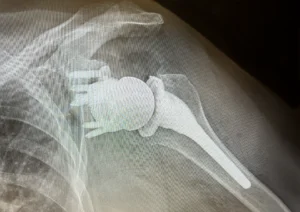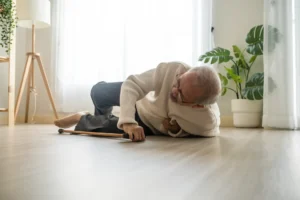Introduction
Adhesive capsulitis, also called frozen shoulder, is a painful condition. It results in a severe loss of motion in the shoulder. It may follow an injury, or it may arise gradually with no injury or warning.
This guide will help you understand
- What causes frozen shoulder
- What tests your doctor will do to diagnose it
- How you can regain use of your shoulder.
Anatomy
The shoulder is made up of three bones: the scapula (shoulder blade), the humerus (upper arm bone), and the clavicle (collarbone). The joint capsule is a watertight sac that encloses the joint and the fluids that bathe and lubricate it.
The walls of the joint capsule are made up of ligaments. Ligaments are soft connective tissues that attach bones to bones. The joint capsule has a considerable amount of slack, loose tissue, so the shoulder is unrestricted as it moves through its large range of motion.
In a frozen shoulder, inflammation in the joint makes the normally loose parts of the joint capsule stick together. This seriously limits the shoulder’s ability to move and causes the shoulder to freeze.
Related Document: A Patient’s Guide to Shoulder Anatomy
Causes
The cause of frozen shoulder is largely a mystery. One theory is that it may be caused by an autoimmune reaction. In an autoimmune reaction, the body’s defense system, which normally protects it from infection, mistakenly begins to attack the tissues of the body. This causes an intense inflammatory reaction in the tissue that is under attack. Frozen shoulder is very common in diabetics and patients with endocrine disorders.
No one knows why this occurs so suddenly. A frozen shoulder may begin after a shoulder injury, fracture, or surgery. It can also start if the shoulder is not being used normally. This can happen after a wrist fracture when the arm is kept in a sling for several weeks. For some reason, immobilizing a joint after an injury seems to trigger an autoimmune response in some people.
Frozen shoulder has also been known to occur after surgery unrelated to the shoulder, even after recovering from a heart attack. Other shoulder problems like bursitis, rotator cuff tears, or impingement syndrome can end up causing a frozen shoulder.
Doctors theorize that the underlying condition may cause chronic inflammation and pain that make you use that shoulder less. This sets up a situation that can create a frozen shoulder. Usually, the frozen shoulder must be treated first to regain its ability to move before the underlying problem can be addressed.
Related Document: A Patient’s Guide to Impingement Syndrome
Related Document: A Patient’s Guide to Rotator Cuff Tears
Symptoms
The symptoms of a frozen shoulder are primarily shoulder pain and a reduced range of motion in the joint. The range of motion is the same whether you are trying to move the shoulder yourself or someone else is trying to move the arm for you.
There comes a point in each direction of movement where the motion simply stops as if something is blocking it. At this point, the shoulder usually hurts. The shoulder can also be quite painful at night. The tightness in the shoulder can make it difficult to do regular activities like getting dressed, combing your hair, or reaching across a table.
Diagnosis
The diagnosis of frozen shoulder is usually made on the basis of your medical history and physical examination. One key finding that helps differentiate a frozen shoulder from a rotator cuff tear is how the shoulder moves. With a frozen shoulder, the shoulder motion is the same whether the patient or the doctor tries to move the arm. With a rotator cuff tear, the patient may have difficulty moving the arm. But when someone else lifts the arm it can be moved through a normal range of motion.
As your ability to move your shoulder increases, your doctor may suggest tests to rule out an underlying condition, such as impingement or a rotator cuff tear. Probably the most common test used is magnetic resonance imaging (MRI). An MRI scan is a special imaging test that uses magnetic waves to create pictures that show the tissues of the shoulder in slices.


Nonsurgical Treatment
Treatment of frozen shoulder can be frustrating and slow. Most cases eventually improve, but the process may take 9-18 months. The goal of your initial treatment is to decrease inflammation and increase the range of motion of the shoulder. Dr. Kiritsis will probably recommend anti-inflammatory medications, such as ibuprofen.
Physical or occupational therapy treatments are a critical part of helping you regain the motion and function of your shoulder. Treatments are directed at getting the muscles to relax. Therapists use heat and hands-on treatments to stretch the joint capsule and muscle tissues of the shoulder.
You will also be given exercises and stretches to do as part of a home program. You may need therapy treatments for three to four months before you get full shoulder motion and function back. Performing your exercises throughout the day is very important. Also, moist heat is usually very helpful.
Dr. Kiritsis may also recommend an injection of cortisone and a long-acting anesthetic, similar to lidocaine, to get the inflammation under control. Cortisone is a steroid that is very effective at reducing inflammation. Controlling the inflammation relieves some pain and allows the stretching program to be more effective. In some cases, it helps to inject a long-acting anesthetic with the cortisone right before a stretching session. This allows your therapist to manually break up the adhesions while the shoulder is numb from the anesthetic.
Surgery
If progress in rehabilitation is slow, Dr. Kiritsis may recommend manipulation under anesthesia. This means you are put to sleep with general anesthesia. Then Dr. Kiritsis slowly and carefully stretches your shoulder joint. The manipulation stretches the shoulder joint capsule and breaks up the scar tissue. In most cases, the manipulation improves motion in the joint faster than allowing nature to take its course.
This procedure has risks. There is a very slight chance the stretching can injure the nerves of the brachial plexus, the network of nerves running to your arm. And there is a risk of fracturing the humerus (the bone of the upper arm), especially in people who have osteoporosis (fragile bones).

Arthroscopic Release
When it becomes clear that physical therapy and manipulation under anesthesia have not improved shoulder motion, arthroscopic release may be needed. This procedure is usually done using an anesthesia block to deaden the arm. Dr. Kiritsis uses an arthroscope to see inside the shoulder. An arthroscope is a slender tube with a camera attached. It allows Dr. Kiritsis to see inside the joint.
During the athroscopic procedure, Dr. Kiritsis cuts (releases) scar tissue, the ligament on top of the shoulder (coracohumeral ligament), and a small portion of the joint capsule. At the end of the release procedure, Dr. Kiritsis gently manipulates the shoulder to gain additional motion. Steroid medicine may be injected into the shoulder joint at the completion of the procedure.
Nonsurgical Rehabilitation
The primary goal of physical therapy is to help you regain a full range of motion in the shoulder. If your pain is too strong at first to begin working on shoulder movement, your therapist may need to start with treatments to help control the pain.
Treatments to ease pain include ice, heat, ultrasound, and electrical stimulation. Therapists also use massage or other types of hands-on treatment to ease muscle spasms and pain.
When your shoulder is ready, therapy will focus on regaining your shoulder’s movement. Sessions may begin with treatments like moist hot packs or ultrasounds. These treatments relax the muscles and get the shoulder tissues ready to be stretched.
Therapists then begin working to loosen up the shoulder joint, especially the joint capsule. You can also get a good stretch using an overhead shoulder pulley in the clinic or as part of a home program.
After Surgery
After arthroscopic release, you’ll likely begin using a shoulder pulley on a daily basis and will visit the therapist frequently. You’ll probably be encouraged to use the treated arm in everyday activities. Strengthening exercises are not begun for four to six weeks after the procedure. You might participate in physical or occupational therapy for up to two months after arthroscopic release.
You’ll resume therapy usually on the same day as the shoulder manipulation. Dr. Kiritsis usually has his patients attend therapy every day for one week. Your therapist will treat you with aggressive stretching to help maximize the benefits of shoulder manipulation. The stretching also keeps scar tissue from forming and binding the capsule again. Your shoulder movement should improve continually after the manipulation and therapy. If not, you may require an arthroscopic release.
Once your shoulder is moving better, treatment is directed toward shoulder strengthening and function. These exercises focus on the rotator cuff and shoulder blade muscles. Your therapist will help you retrain these muscles to help keep the ball of the humerus centered in the socket. This lets your shoulder move smoothly during all your activities.
The therapist’s goal is to help you regain shoulder motion, strength, and function. When you are well under way, regular visits to the therapist’s office will end. Your therapist will continue to be a resource, but you will be in charge of doing your exercises as part of an ongoing home program.




